What Is Resin? – What Is Resin Made of and How Can You Use It?
Resin has become something of a staple in the crafting community as of late, and as a result, there are many budding artists trying to figure out exactly what resin is and how to use it. Resin has actually been around for a really long time, but thanks to the advent of modern technology, resin has become relatively inexpensive and accessible to the general public. This substance is used in pretty much every industry all over the world, so let’s have a look at exactly what it is and how you can go about using it not only for creative applications but to repair and improve things in your everyday life.
What Is Resin?
What is resin? Put simply, resin is a thermoplastic that happens to be extremely resilient and versatile. However, before we get into the specifics let’s have a look at how resin came to be and why it was invented in the first place. Resin came to be in the late 1930s when scientists were experimenting with both naturally occurring resins like those found in the bark of trees and purely synthetic resin variants.
These resins were some of the earliest ever discovered and did not closely resemble the store-bought resin that we know today. Epoxy resin in particular skyrocketed in popularity around the early 1940s, as the formula was patented and was used in applications like dental prosthetics, industrial-grade adhesives, and even crude forms of resin casting as time went on.

During the late 1940s epoxy resin and its subsequent applications were becoming pretty well known both in the scientific community and among artists, both of which use epoxy to push the boundaries limits of their respective crafts to new heights. It was around this time that new compositions of epoxy were being developed for various other applications too.
How does resin work though? Well, generally speaking (as there is more than one type of resin) resin consists of a resin polymer that when combined with a catalyst (or hardener) undergoes a thermic reaction which causes the resin to solidify into a form of your choice by use of a mold.
This means that what you’re capable of making with resin is limited only by your imagination and ambition.
EBook Recommendation for working with Resin
If you would like to start working with resin, we recommend the eBook “Epoxy Resin Arts and Crafts for Beginners” from the resin artists at acrylgiessen.com.
Epoxy Resin Arts and Crafts for Beginners
Your Go-To Guide for start working with Epoxy Resin. Learn creating fascinating Resin Arts and Crafts within minutes. All the tips and tricks that nobody tells you when you start. Including several detailed tutorials for your first projects.
Have a look inside the eBook
What Is Resin Made Of?
What is resin made of? Well, if your only exposure to the world of chemical engineering is through television or high school chemistry class, you can rest assured that you’ll still be able to understand this perfectly. Epoxy resin specifically, is created when acidic hydroxy groups interact with a substance called epichlorohydrin.
When these two chemicals interact with one another the resulting epoxy is known as glycidyl-based epoxy resins. There are other types of epoxy resins that can be made by adding different substances to base chemicals to form a ploy (or resin) with specific characteristics. These characteristics can then be alerted or improved for certain industries and applications.
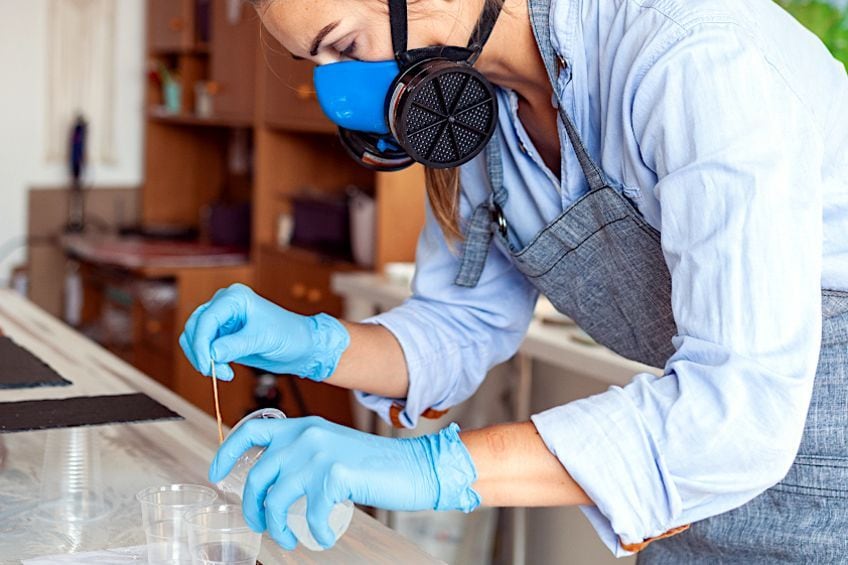
Conventional epoxy resin, the kind that you would buy at crafting stores has some inherent qualities regardless of brand and or price. Some of these qualities include being completely food safe once they have had a chance to cure completely, being highly resistant to the effects of heat and open flames, and of course the ability to absorb impact and abrasion while insulating a surface.
How is resin made exactly though? Well, tree resin is a simple chemical reaction that takes place when a tree is injured. The plant will secrete the transparent substance which seals the orifice created by the wound. Synthetic resin on the other hand is a bit more complicated to make, well at least to us humans who can’t secrete resin. Synthetic resin is made when hydrogen, oxygen, sulfur, and carbon atoms are combined with a chemical catalyst to produce the resin we use today. How is resin made, then?
Resin can be made either via a scientific process or when a tree gets hurt and needs to cover the wound.
What Are the Pros and Cons of Epoxy Resin?
While there are loads of people that use epoxy resin across the world, it isn’t a cure-all substance that solves every problem. In fact, there are quite a few negative characteristics that epoxy resin and other resin types exhibit that might make you think twice before using it for your next workpiece. This being said, let’s have a look at a few of the positive and negative characteristics of this substance before you decide to use some yourself.
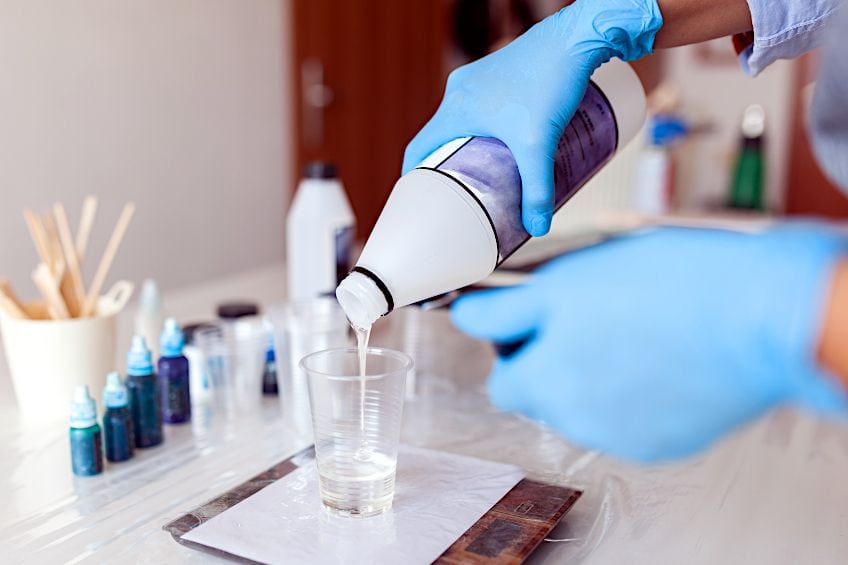
Advantages (Pros)
In our opinion, the pros of resin typically outweigh the cons, but this does depend on the application. Resin is one of the most versatile substances on the face of the planet. It can be used to create entire forms from scratch, and these creations will often outlast those made from more conventional materials. Why? Polys (which is what resin is classified as) do not degrade or damage easily, which means they’ll likely outlast you in terms of longevity.
Synthetic resin that has been completely cured is also 100% food safe, which means that you can coat cutlery plates, and surfaces that are in regular contact with food using synthetic resin. The FDA (Food and drug administration) does have a specific formula that manufacturers need to follow for their resin products to be considered food safe though.
Synthetic resin is also extremely durable which is why it’s used to coat surfaces and create things like toys or detailed model figurines.
Resin has great shape retention, which is why it’s so sought after in applications where surfaces need to be protected from impact, abrasion, or traffic in highly trafficked areas. It’s also really cheap, which means you can accomplish a lot for relatively little monetary investment.
Resin is also resistant to other forces like extreme heat and/or exposure to open flames. This is why it is typically used to coat things like kitchen countertops and stovetop surfaces. Wooden surfaces can also be protected using resin, which is ideal if you enjoy wooden finishes but don’t want the headache of dealing with a constant fire hazard in your cooking space.
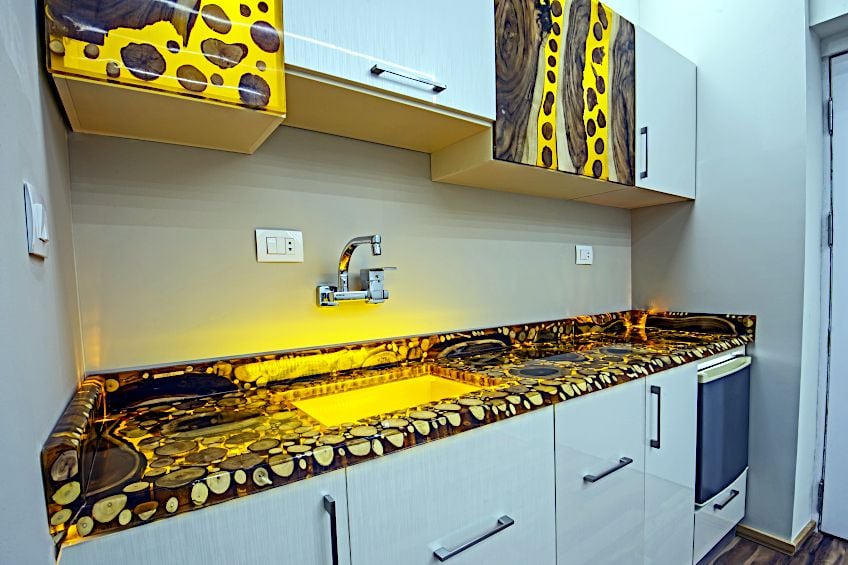
The obvious and arguably the most prominent advantage of using resin for crafting applications is that it is super easy to work with compared to conventional materials. All that you need to do is mix your resin and hardener together and apply it to the surface of your workpiece or pour it into the mold of your choice to create a resin casting.
[su_shadow style=”simple”][su_panel]- Robust nature
- Completely food-safe once cured
- Extremely resistant to impact and abrasion
- Extremely resistant to heat and open flames
- Relatively inexpensive
- Versatile
- Easy to use
Disadvantages (Cons)
As you can see there are loads of advantages to using resin for all of your crafting or surface protection needs, but there are also some notable advantages you should know before you go about slapping resin on everything in sight. For starters, once the resin has been allowed to cure it can be decidedly difficult to get rid of, and nine times out of ten you’ll find yourself getting out your power sander to free the surface of your workpiece from the grips of the resin.
As a second point, resin happens to contain a few substances which aren’t particularly good for the environment. These substances are known as volatile organic chemicals or VOCs for short, and besides being bad for the overall environment they can also cause some serious discomfort if they’re inhaled or ingested.
This being said, if you’re going to be working with them, especially indoors, you should always wear the appropriate personal protective gear.
Thirdly, besides being really bad for the environment and toxic to inhale, the fumes produced when resin and hardener are combined are extremely flammable. It goes without saying then that if you’re working with resin you should work in a well-ventilated area, or outdoors as often as possible. If you’re unable to work outdoors, try to establish a crossflow of air to dissipate any fumes that could accumulate. Also, don’t work around anything that could potentially ignite these fumes.
Lastly, the resin can be a bit messy to work with if you’re inexperienced. Remember that resin is inherently sticky and hard to remove, so spilling some means using solvents and sandpaper to get it loose if it’s had a chance to fully cure before you could clean it up. Additionally, if your resin has crystallized or you have mixed your resin incorrectly, it will not cure. This can make it a potentially tricky substance to work with.
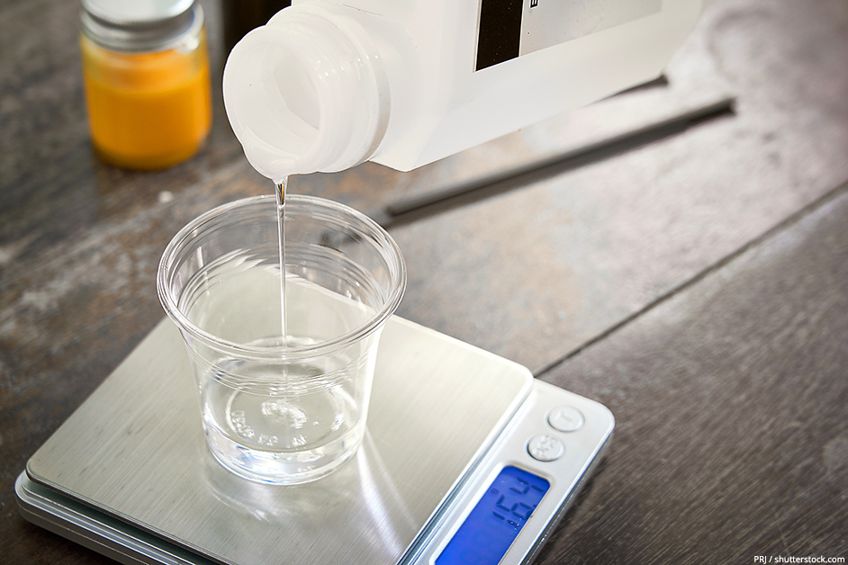
Another notably challenging thing about working with synthetic resin is that you can only use certain resins for certain applications. Arguably the best example of this is that you can’t use deep pour resin for surface pour applications, and you cannot use deep pour resin fur surface coating applications. This can be tricky for those who are new to the medium and can result in some frustrating mistakes.
[su_shadow style=”simple”][su_panel]- Challenging to remove once applied
- Contains volatile organic chemicals
- Produces highly flammable gasses
- Can be difficult to clean when spilled
- Certain resins can only be used for their intended applications
- Must be worked within a well-ventilated area
What Is Resin Used For?
What is resin used for, you ask? As we mentioned previously there are loads of things you can make with resin, it is used in nearly every industry all over the world for various applications. These days, resin is primarily used for crafting purposes and if you have a look at platforms like Instagram and Pinterest you’ll come across some pretty incredible stuff. This being said, let’s have a look at some of the common things resin is used for in our everyday lives.
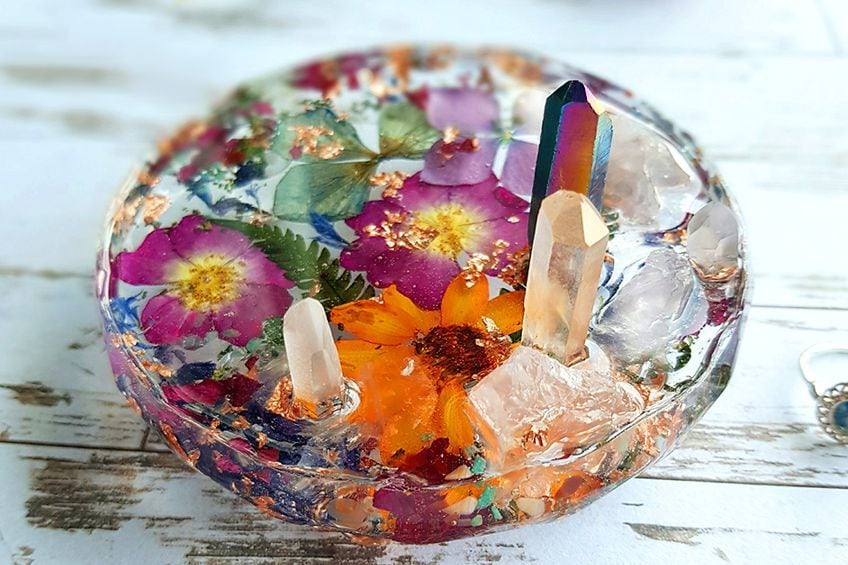
Surface Coatings
While crafting is definitely an art, it has a more practical application, so we think it deserves its own mention separate from traditional fine art pieces. `Coating wood crafts, especially furniture tops in resin, are extremely common in the woodworking industry. This provides a layer of protection to the workpiece against impact and abrasion, but this practice isn’t limited to wooden surfaces.
Stone surfaces like granite and marble are also commonly coated in resin to protect these rather expensive surfaces from everyday hazards.
Resin Jewelry
Resin jewelry has become really popular as an inexpensive and unrestricted way for you to create accessories for your everyday life. All that you need is a mold and some resin and before you know it you can have dozens of custom jewelry pieces for you to enjoy or to gift to your friends and family! You can add things like acrylic paint, dyes, glitter, and even food coloring to customize your resin jewelry. Anything is possible, bangles, chokers, bracelets, rings, and even tiaras can be made with resin.
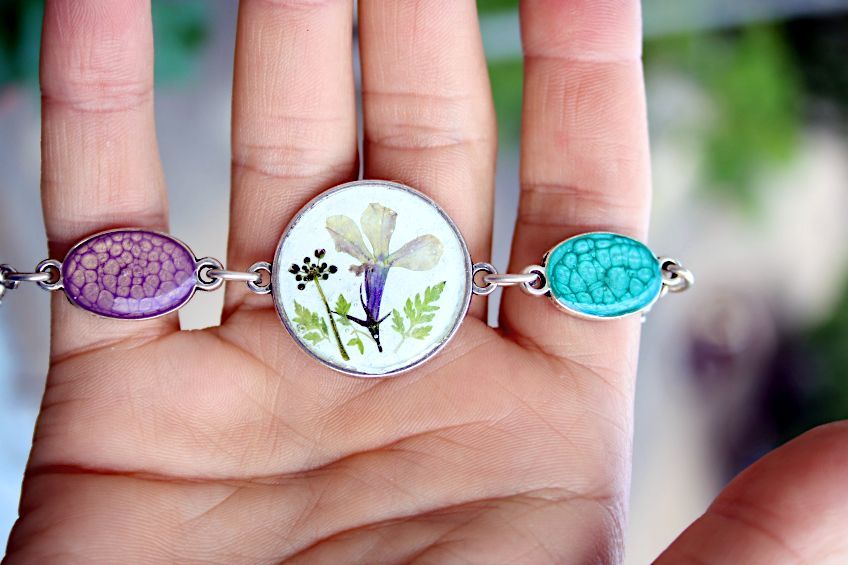
Novelty Accessories
Novelty accessories are one of the best ways for you to create something amazing with resin that you can use in your everyday life. What do we mean by novelty accessories? Well, these can be anything from keychains, to pendants, to book covers, to smartphone covers, and even pen holders!
These can be used in your home or office, and you can personalize them with things like photos or quotes which end to make great gifts for friends and family.
Artwork
As we mentioned previously, art is something that’s made most commonly with resin, but the sheer variety of art you’re able to make with resin is astounding. A crowd favorite is resin cast figurines which can be painted and coated in near-infinite variations. Resin-coated paintings and even mixed media resin artwork are really common these days, with impressive displays of ingenuity and completely original thinking all around.

Household Items
There are loads of things that you can make with resin that you can use all over your home. Some of the most popular things to make using resin are coasters, cutting boards, serving trays, tabletops, lamps, picture frames, terrariums, bowls, and so much more.
The cool thing about making household items from resin is that you have the freedom to cater to the unique style and aesthetic of your home.
Are There Different Types of Resin?
There are indeed different types of resin on the market, and each resin type has been designed to fill a particular application. These resins often vary in consistency, how deep they can be poured, how long they take to cure completely, and even in their tolerances to certain external forces. Here are a few resin types that you could encounter on your journey exploring this medium.
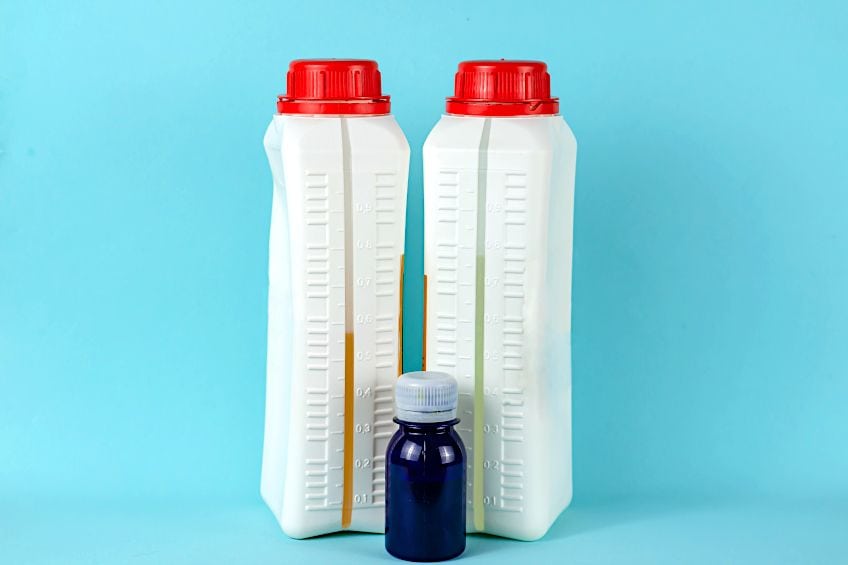
Polyester Resin
If you’re wondering how many things in your daily life are made of resin, stop thinking about it because there are way too many to count. Although, most of them are probably made from this type of resin. Polyester resin is extremely flexible and easy to mold, not to mention that its highly resistant to direct heat, open flames, and even chemical damage.
This resin is used to make fillers, construction materials, fishing poles, accessories, and even surface coatings.
Acrylic Resin
Acrylic resins are unique because they’re formed from acrylic acids which give them some cool characteristics. Like most other thermoplastics, this resin has good shape retention, but unlike most thermoplastics, this one is immune to the effects of UV exposure and has a pretty strong tensile strength too. As a result, acrylic resin is used to create adhesives, surface coatings, elastics, and even decoration.
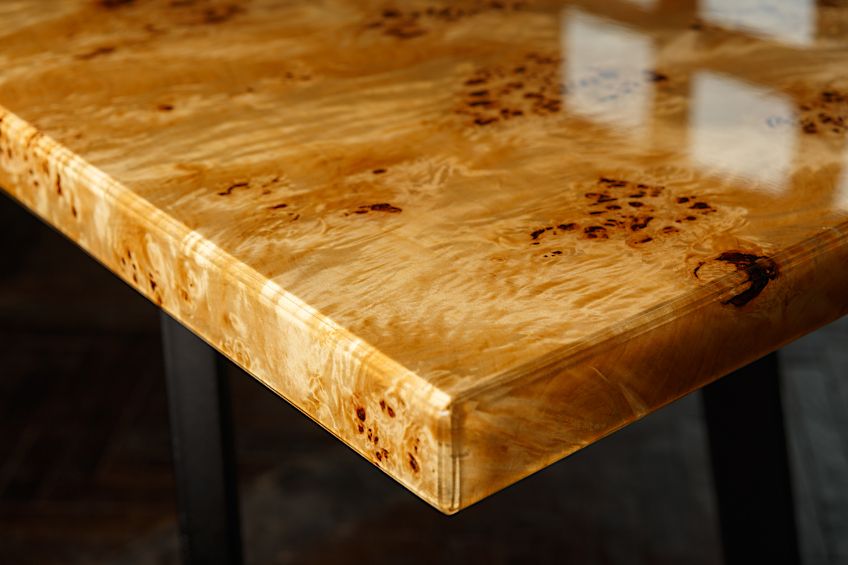
Polyurethane Resin
Polyurethane (PU) resin is kind of unique when it comes to resin types. Why? Polyurethane resins are some of the most versatile of all the polytypes as they’re used to make both adhesives and solid forms depending on what is needed.
They really hit that sweet spot of being really stretchy and really hard at the same time, and therefore are used to create adhesives, insulating materials, and even foam in some instances.
Alkyd Resin
This type of resin is typically used to create insulation either on or around electrical components. Why? It has a high resistance to both heat and electrical contact, not to mention that it stands up to chemical corrosion really well. How is it made? Alkyd resin is made by mixing polybasic acids with polyhydric alcohols.
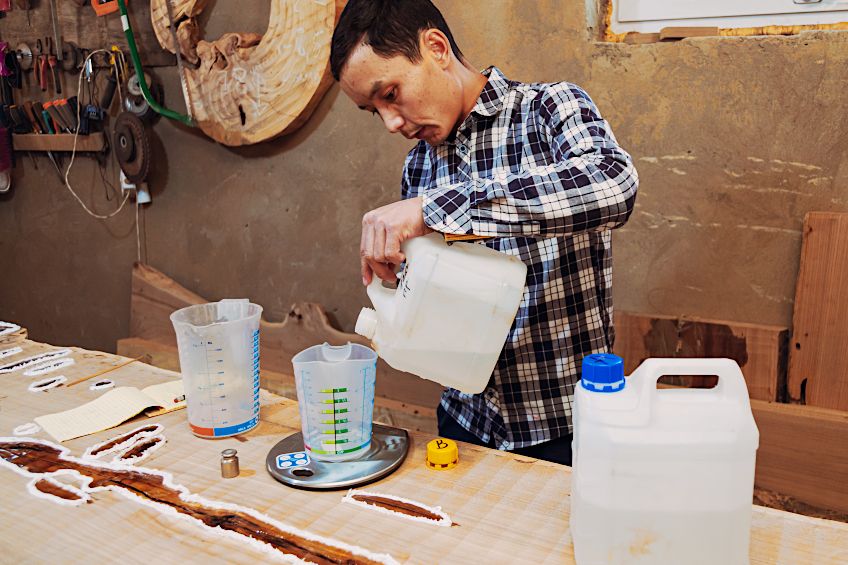
Polyamide Resin
If you’re looking for a rather hard-wearing resin type, then the polyamide resin variety might be right up your alley. This resin type has a little surface friction, is resistant to chemical burns, has great shape retention, and is pretty lightweight too.
This type of resin is used to create inner fibers, sutures, bearings, and even bottles.
Polycarbonate Resin
If you think you’ve seen the term polycarbonate before, it’s because you probably have. This resin type is coveted for its ability to reflect light and its tendency not to falter when exposed to direct current or dye agents. It’s so sturdy that it can be used in place of conventional materials like metal, and is primarily used to create things like helmets, insulators, and lenses.

Polyethylene Resin
Polyethylene resin is a run-of-the-mill variation that is used more than any other resin type we’ve covered so far. In fact, we use millions and millions of tons of the stuff every single year even in industries as innocuous as bookmaking! Polyethylene is pretty flexible, does a good job in resisting the effects of moisture, and has decent shape retention too.
We use this reis type in the insulating surfaces, making containers, creating piping, and even laminating things.
Phenolic Resin
If you’re looking for a resin that is versatile and easy to work with, then phenolic resin is just what you’re looking for. Used in the manufacturing industry to line brakes and insulate electrical components, this resin’s resistance to moisture and chemical damage has made it a go-to for those looking to create high-quality adhesives, molds, and protective shells.

Polypropylene Resin
Polypropylene is something of a special resin type in the thermoplastic community. What makes it so special? Well, it doesn’t contain any Bisphenol A (BPA) and is therefore colorless, relatively light, and has decent resistance to heat. This resin is typically used in medical environments because it can be sterilized without compromising the integrity of the plastic itself.
Because of this, they’re also used to make kids’ toys and other surfaces that might need to be disinfected regularly.
Epoxy Resin
This is the type of resin you usually find in hardware stores when you’re looking to repair something. This type of epoxy is used primarily to make adhesives and create surface coatings . It is extremely resistant to heat, impact, abrasion, and moisture, which makes it ideal for robust applications in both its surface coating and adhesive forms.
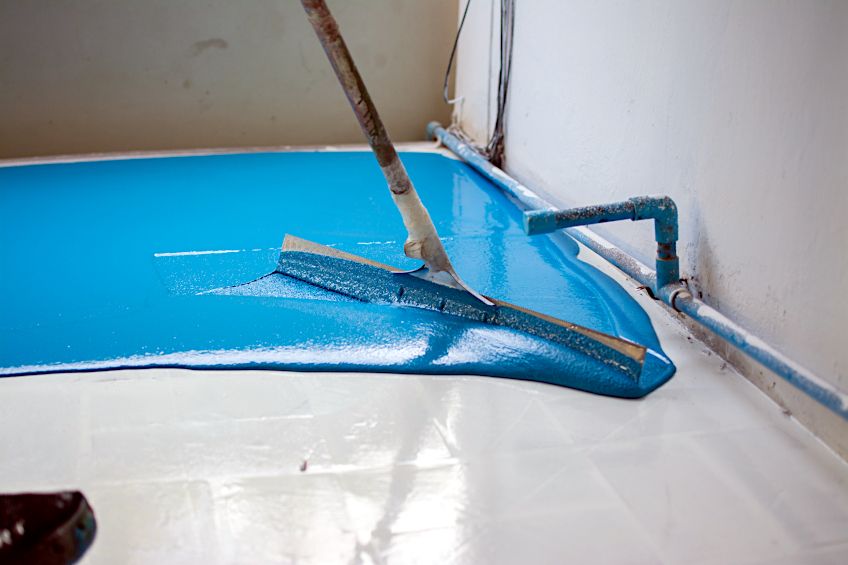
Polystyrene Resin
While not quite as common as polyethylene resins this resin is still pretty common in most industries around the world. They aren’t particularly special, but they’re really cheap to make and don’t require a lot of special processes to synthesize.
This resin type is flexible and like polyethylene, they are used to make piping, rubber, insulation, containers, and even interior trims for vehicles.
Silicone Resin
Silicone is also a relatively common poly and is used in a variety of applications in a number of industries. This resin is commonly found in large tubes, or when used as an adhesive, can be purchased in little dispensers. Silicone resin is highly resistant to moisture, and hot and cold temperatures and is therefore used to seal edges, create rubbers, and even plug holes!
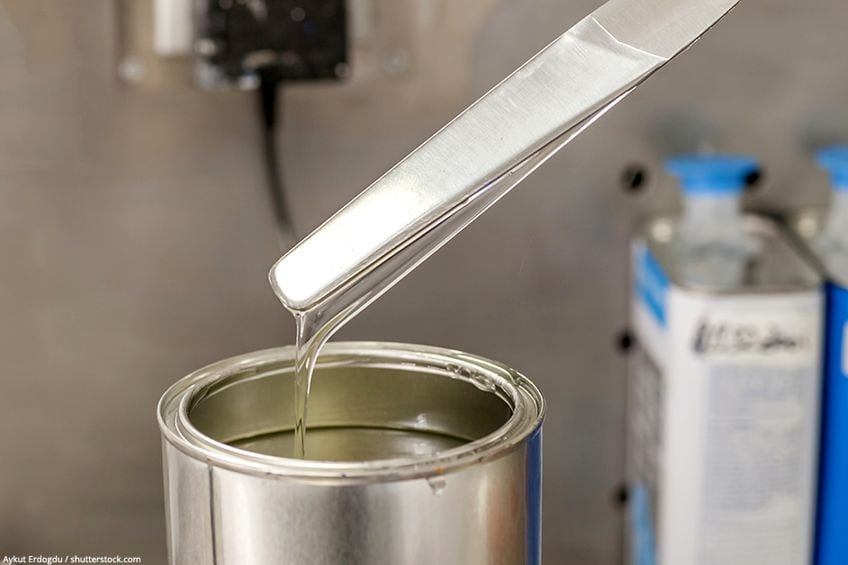
Now that you know what a resin is, how the resin is made, some of the pros and cons associated with the substance, what can be made from it, and the different types of resin you might encounter when using this medium, it’s time for you to get out there and put your new-found knowledge to the test. Remember to always work in a well-ventilated area when working with resin and to always wear the appropriate personal protective gear.
Frequently Asked Questions
Where Does Resin Come From?
Where does resin come from? Well, there are two types of resin each of which come from different places. Natural resin is typically produced by trees as a defense mechanism against injuries, whereas synthetic resin is made by combining various molecules in certain compositions to create materials with certain properties.
What Material Is Resin?
What material is resin? Although most people consider resin to be just another plastic, it’s much more than that., Resin is a composite thermoplastic bland that has the potential to mimic the appearance and properties of more conventional materials like metal.
Is Resin Stronger Than Wood?
This can be a challenging question to answer considering that there are many types of resin. Although resin can be engineered to be stronger and far more durable than wood if that’s what you set out to do, it would like some of the natural qualities wood has, just as wood would lack the inherent qualities of resin.
In 2005, Charlene completed her Wellness Diplomas in Therapeutic Aromatherapy and Reflexology from the International School of Reflexology and Meridian Therapy. She worked for a company offering corporate wellness programs for a couple of years, before opening up her own therapy practice. It was in 2015 that a friend, who was a digital marketer, asked her to join her company as a content creator, and this is where she found her excitement for writing.
Since joining the content writing world, she has gained a lot of experience over the years writing on a diverse selection of topics, from beauty, health, wellness, travel, and more. Due to various circumstances, she had to close her therapy practice and is now a full-time freelance writer. Being a creative person, she could not pass up the opportunity to contribute to the Art in Context team, where is was in her element, writing about a variety of art and craft topics. Contributing articles for over three years now, her knowledge in this area has grown, and she has gotten to explore her creativity and improve her research and writing skills.
Charlene Lewis has been working for artincontext.org since the relaunch in 2020. She is an experienced writer and mainly focuses on the topics of color theory, painting and drawing.
Learn more about Charlene Lewis and the Art in Context Team.
Cite this Article
Charlene, Lewis, “What Is Resin? – What Is Resin Made of and How Can You Use It?.” Art in Context. April 29, 2022. URL: https://artincontext.org/what-is-resin/
Lewis, C. (2022, 29 April). What Is Resin? – What Is Resin Made of and How Can You Use It?. Art in Context. https://artincontext.org/what-is-resin/
Lewis, Charlene. “What Is Resin? – What Is Resin Made of and How Can You Use It?.” Art in Context, April 29, 2022. https://artincontext.org/what-is-resin/.


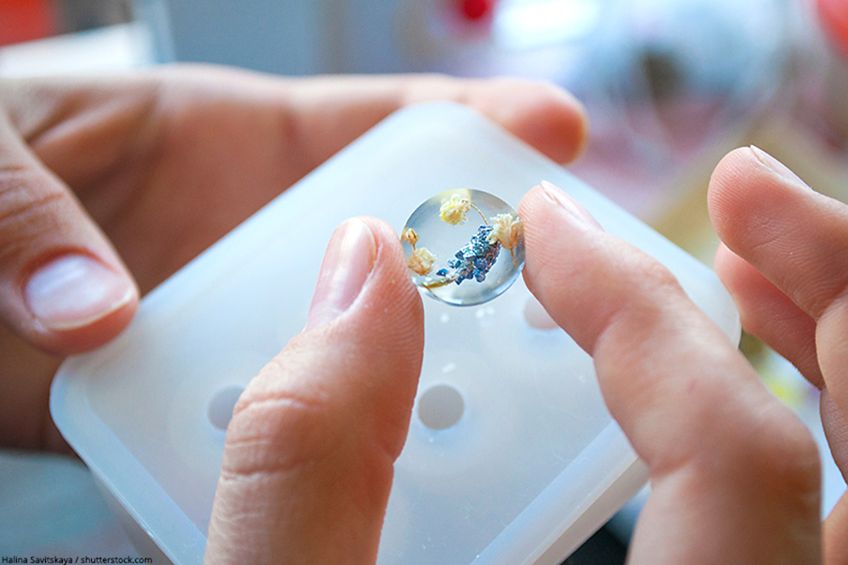
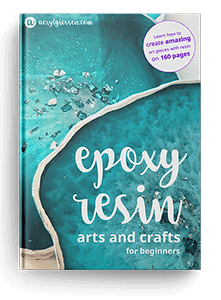








Hi The first time I tried using epoxy resin, it did not cure. The design remained sticky for a long time. Quite a long time later, as I crafted something different, it occurred to me that possibly a spray bottle of Color Maxx Clear epoxy might work to harden the surface of the of the above-mentioned design, still sticky. I sprayed the design still in a metal mold. A while later, when the epoxy was dried, the surface was not only hard, it was very hard. To this day, the surface is smooth, hard and impossible to remove from the mold. I painted the mold and the entire design is so beautiful, filled with jewelry beads of all kinds. The metal heart-shaped mold has a hole at the top for hanging. I have not decided or figured out that part since my apartment is rented. I laid it on a shelf where I can see it or remove it any time. Thanks for all of the resin information. I look forward to making another attempt at resin art. Mollie
Hi Mollie,
Thank you for sharing your experience! It’s great that you found a solution by using the Color Maxx Clear epoxy spray. Sometimes resin projects can be tricky, and experimenting is part of the learning curve. Your heart-shaped piece sounds beautiful, and the fact that it remains firmly set and smooth is a testament to your patience and creativity. Keep experimenting, and don’t hesitate to try different techniques or molds. Good luck with your next resin art adventure!